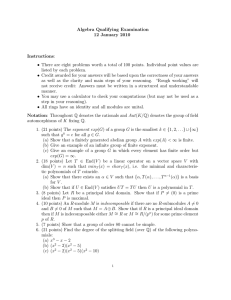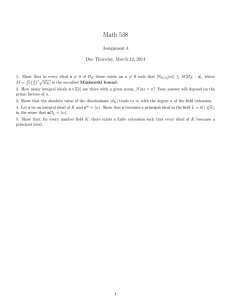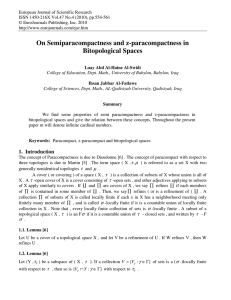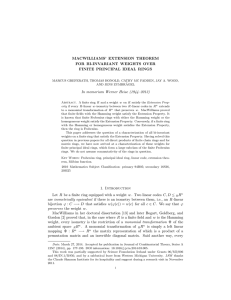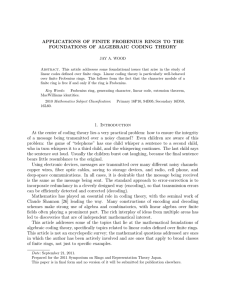7202 (Algebra 4: Groups and Rings)
advertisement
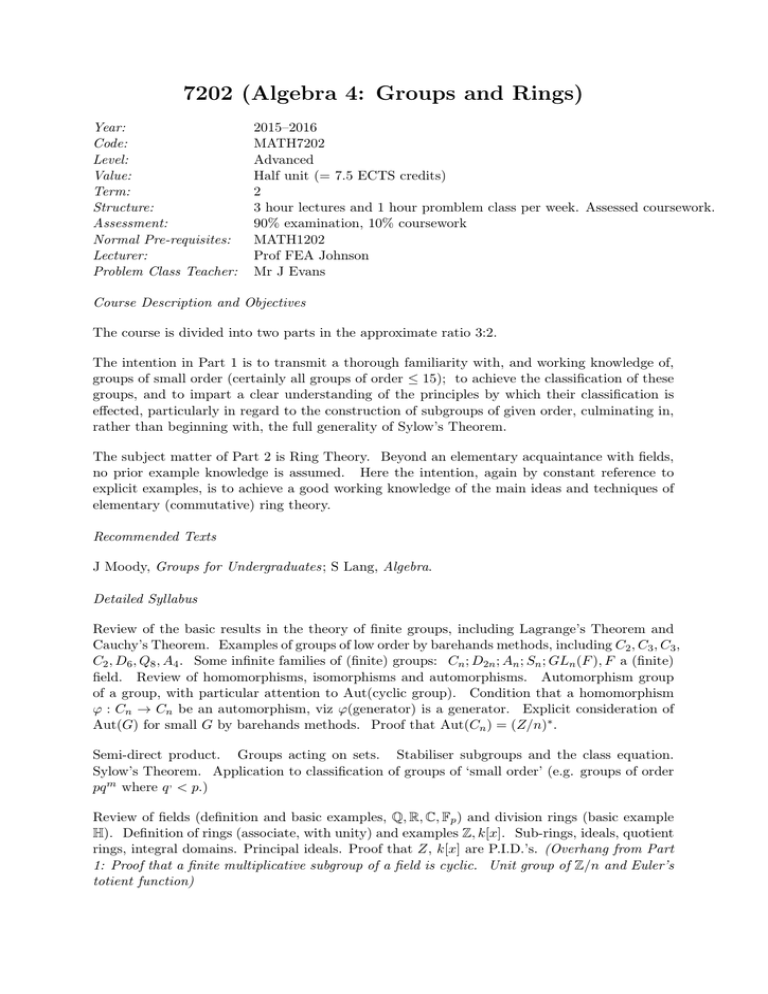
7202 (Algebra 4: Groups and Rings)
Year:
Code:
Level:
Value:
Term:
Structure:
Assessment:
Normal Pre-requisites:
Lecturer:
Problem Class Teacher:
2015–2016
MATH7202
Advanced
Half unit (= 7.5 ECTS credits)
2
3 hour lectures and 1 hour promblem class per week. Assessed coursework.
90% examination, 10% coursework
MATH1202
Prof FEA Johnson
Mr J Evans
Course Description and Objectives
The course is divided into two parts in the approximate ratio 3:2.
The intention in Part 1 is to transmit a thorough familiarity with, and working knowledge of,
groups of small order (certainly all groups of order ≤ 15); to achieve the classification of these
groups, and to impart a clear understanding of the principles by which their classification is
effected, particularly in regard to the construction of subgroups of given order, culminating in,
rather than beginning with, the full generality of Sylow’s Theorem.
The subject matter of Part 2 is Ring Theory. Beyond an elementary acquaintance with fields,
no prior example knowledge is assumed. Here the intention, again by constant reference to
explicit examples, is to achieve a good working knowledge of the main ideas and techniques of
elementary (commutative) ring theory.
Recommended Texts
J Moody, Groups for Undergraduates; S Lang, Algebra.
Detailed Syllabus
Review of the basic results in the theory of finite groups, including Lagrange’s Theorem and
Cauchy’s Theorem. Examples of groups of low order by barehands methods, including C2 , C3 , C3 ,
C2 , D6 , Q8 , A4 . Some infinite families of (finite) groups: Cn ; D2n ; An ; Sn ; GLn (F ), F a (finite)
field. Review of homomorphisms, isomorphisms and automorphisms. Automorphism group
of a group, with particular attention to Aut(cyclic group). Condition that a homomorphism
ϕ : Cn → Cn be an automorphism, viz ϕ(generator) is a generator. Explicit consideration of
Aut(G) for small G by barehands methods. Proof that Aut(Cn ) = (Z/n)∗ .
Semi-direct product. Groups acting on sets. Stabiliser subgroups and the class equation.
Sylow’s Theorem. Application to classification of groups of ‘small order’ (e.g. groups of order
pq m where q , < p.)
Review of fields (definition and basic examples, Q, R, C, Fp ) and division rings (basic example
H). Definition of rings (associate, with unity) and examples Z, k[x]. Sub-rings, ideals, quotient
rings, integral domains. Principal ideals. Proof that Z, k[x] are P.I.D.’s. (Overhang from Part
1: Proof that a finite multiplicative subgroup of a field is cyclic. Unit group of Z/n and Euler’s
totient function)
Proof that a finite integral domain is a field; more generally, an integral domain of finite dimension over a subfield in a field. Construction of extension fields as quotients k[x]/(q(x)) with q(x)
an irreducible element of k[x]. Explicit illustration with examples Fp [x]/(q(x)) with p = 2, 3, 4
and q(x) an irreducible quadratic. Eisenstein’s Criterion. Gauss’s Lemma. Irreducibility over
Z (and hence Q) of
Cp (x) = xp+1 + ... + x + 1 for p prime
Algorithm for the factorisation of the cyclomotic polynomials xn − 1 into Z-irreducible (and
hence Q-irreducible) factors, xn − 1 = Π{Cc (x) : d |n }. Informal proof that Cd (x) =
Π{(x − w) : ord(w) = d)}. Finite subgroup of F∗ is cyclic.
April 2015 MATH7202



